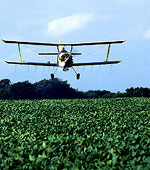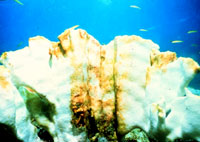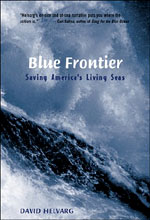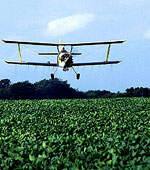This essay is adapted from Blue Frontier: Saving America’s Living Seas.
Predictable but unreported impacts from this spring’s flooding on the Mississippi River will be an expanded dead zone in the Gulf of Mexico, more southern beach closures, and more dying coral in the Florida Keys National Marine Sanctuary.

A pesticide begins its journey to the sea.
Every day, some 32 billion gallons of agricultural, urban, and industrial runoff (including oil, pesticides, and manure) pollutes America’s marine environment. The pollution is suffocating our coastal bays and estuaries, poisoning marine mammals, and feeding outbreaks of stinging jellies and harmful algal blooms that contribute to some 7,000 beach closures a year.
Most of this is attributable to so-called nitrogen-rich nonpoint-source pollution, pollution from agricultural and other sources that follows down our rivers and watersheds and into the sea.
Nitrogen is essential for soil productivity, and can be supplied by animal waste and plant decay. But too much of a good thing can also be a bad thing, as anyone who’s ever had a hangover will attest. According to various studies and recent reports in Science and Scientific American, synthetic, nitrogen-rich fertilizers developed after World War II, along with the burning of fossil fuels, doubled the global nitrogen cycle between 1960 and 1990.
Along with natural nitrogen found in air, soil and lightening, this added input is too much for the land to handle, and so the surplus is washed off into the world’s rivers, estuaries and oceans where it ends up feeding giant algae blooms.

Florida coral: bleach blanket bingo.
Photo: NOAA.
The most productive and diverse parts of America’s seas, such as Florida’s coral reefs, need clean, clear, low-nutrient waters to thrive. Algae, by contrast, loves farm waste and other nutrients, and in their presence, will bloom into a green, light-obscuring soup that sucks oxygen out of the water as it decays, killing off massive numbers of reef fish and suffocating living coral. Nutrient pollution from the Mississippi River, along with nutrient runoff from South Florida’s federally subsidized sugar industry and coastal sprawl, eventually ends up on the reefs, according to scientists working on Aquarius, the world’s last underwater research station, located some seven miles off (and 50 feet below the waters of) Key Largo, Fla.
Every spring, the Gulf of Mexico experiences a seasonal algae bloom that creates a huge dead zone, where there is so little dissolved oxygen in the water that no fish or bottom dwelling life can survive. First studied in the 1970s, this dead zone doubled in size following the great Mississippi flood of 1993. Since then, it’s averaged more than 7,000 square miles, about the size of New Jersey, and is expected to again grow to monstrous proportions following this year’s flood.

The Mississippi watershed.
Image: Barataria-Terrebonne National
Estuary Program.
The Mississippi watershed drains 41 percent of the continental U.S. into the Gulf. The watershed includes 52 percent of U.S. farms that during the 1950s and ’60s became increasingly dependent on synthetic chemicals. These commercial fertilizers and pesticides, promoted by the government, American Farm Bureau Federation, and Agricultural Chemicals Association (since renamed the American Crop Protection Association) boosted production, but undermined the long-term viability of the soil.
Today, as a result, corn farmers in states like Illinois and Iowa are caught up in a cycle of chemical dependence, applying 150 pounds of fertilizer per acre. Corporate feedlots for cattle, hogs, and chickens also generate tremendous amounts of largely unregulated methane, ammonia, and nitrogen. Every spring, rain and snowmelt delivers much of this nutrient-rich brew (along with urban and industrial runoff) into the Mississippi.
In North Carolina, corporate hog farming in flood plains has led to waste lagoons overflowing and poisoning coastal waters. Meanwhile, in Los Angeles, storm drains and oily runoff from freeways, parking lots, homes, and businesses has forced beach closures and caused swimmer infections.
Flow Down in History
If history provides lessons, though, there is hope. The U.S. Clean Water Act could serve as a model for how to clean up our coasts. After its passage in 1972, many politicians realized that the new law wasn’t just about plugging “point-source” industrial pipelines that were polluting America’s waterways. It also provided them a chance to cut ribbons on new sewage plants and be seen as friends of public health and the environment.

Blue Frontier
By David Helvarg
W.H. Freeman & Co.,
320 pages, 2001
Wanna buy it?
As a result, Congress has been willing to allocate more than $40 billion in grants for new sewage systems over the last three decades. While more work still needs to be done, dramatic improvements have taken place. Water quality has been restored and wildlife and recreational opportunities expanded for thousands of the nation’s lakes, rivers, and many coastal communities.
The Clean Water Act has shown us that realistic models of restoration are possible, and it holds out the hope of stemming the flow of nonpoint-source pollution, even as past gains under the act are being reversed by the poisonous nutrient-heavy flushing of our coasts.
Unfortunately the Bush administration has indicated it may put a freeze on new regulations by the U.S. EPA that place limits on nutrient runoff from large factory farms. If the administration were serious about encouraging more local and state input into federal decision-making, it would recognize the short-sightedness of this approach.
Why Did the Chicken Pollute the Bay?
On the Chesapeake Bay, meanwhile, states have moved ahead of the feds in demanding nutrient reduction. As a result, they’re turning chicken waste into cheap energy.

Chesapeake Bay.
Photo: USDA.
In 1997, excess nutrients fed an outbreak of Pfiesteria piscicida in warm rivers feeding the Chesapeake Bay. Pfiesteria is a chameleon-like microbe that spends much of its time buried in the mud as a harmless cyst. It can also disguise itself as a green plant, or, given enough nutrients, turn into a deadly predator that can strip the flesh off fish in three minutes. Exposure to it at this stage can also cause lesions, vomiting, and severe nurological disorders in people. More than a dozen fishermen and biologists exposed to the bay’s outbreak have suffered these effects.
Pfiesteria also cost Chesapeake fishermen $40 million in lost sales. It scared so many area residents that bordering states have joined together to try to reduce runoff by preserving land and regulating nutrient sources.
This has spurred some innovative approaches to d
ealing with the 800,000 tons of chicken manure generated every year on the bay’s eastern shore, where some 600 million birds are raised.
A British firm wants to build a 40-megawatt power plant to burn chicken “litter,” which is a mix of chicken manure, sawdust and wood chips. The ash would sell as fertilizer. Allen Family Farms is planning its own smaller 4-megawatt plant, and even Purdue is turning loose manure into fertilizer pellets for sale.
Local farmers, instead of spreading the waste on their land — where it runs off into the bay — are now signing contracts with the Brits to sell their chicken waste for up to $6 a ton. And the poultry industry, which just two years ago was lobbying against nutrient reduction laws, is now warning of a future chicken-waste shortage. The bay is proving that pollution prevention pays.
The Bush administration should look to Maryland’s eastern shore for inspiration and stop being so, excuse the expression, chickenshit. Maybe then it would see that cleaning up our coastal waters and seas can be a chance for innovation, progress, and, yes, profit.



